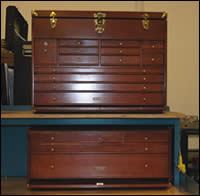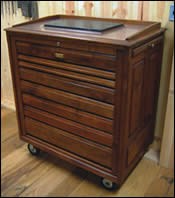A Tribute to Tools and Those Who Use Them
Tools and the boxes that contain them tell a lot about the moldmaker and his/her talents.
It was going to be an interesting day. We had hired a ringer. For many years, our company had staffed our mold maintenance department with guys (and gals) with practical hands-on knowledge that had an affinity for all things mechanical—the more pieces, the better.
But as in many companies, a new boss brings new ideas so our corporate climber made a command decision that no longer would he hire any mold maintenance employee that did not have a four-year mechanical engineering degree. The necessary tools—it was assumed—could be bought and learned anytime.
This news brought both a chuckle and a degree of anxiety among the 15 repairmen currently working in our shop. A competitive group, we were not sure what to expect, or where it would lead. The salaried staff had embraced this idea so completely, that in preparing for the arrival of our new wizard, they decided to line the halls in which to shake his hand as he made his way to the shop.
It was quite a first impression. The ¼-scale fellow looked quite uncomfortable in his spotless blue lab coat with sleeves rolled up and pockets that drug on the ground. But what my fellow cohorts and myself really wanted to see was his tool chest and secrets contained within to really get a grasp on his talents.
Most tradesmen agree that unlike a book, you absolutely can get a good read of a mechanic or toolmaker’s skills by the tool chest and tools that they work with. It stands to reason that the box they push and the condition and organization of their tools within will more than likely reflect their work habits and level of professionalism and aptitude. And if the intention is to accurately and safely disassemble and repair a half a million dollar mold, then these intangibles are naturally prerequisite.
So when the little guy rounded the corner, I was hoping he would be an exception to this long standing shop code, for his multi-colored-flea-market-toolbox was listing severely back and forth on different sized casters, and it took all his muscle and concentration just to steer the thing over to his new desk that had been ceremoniously placed next to the bosses.
A likable chap, he didn’t seem to mind as we began to unceremoniously, and uninvited, rifle through his box looking for any sign of the mechanical genius promised, or at least some basic prior shop experience. All we found were more, cheap flea market tools that had been thrown into a single drawer and a big bag of new rags. Hmmm, no worries here.
Tools you see, and the chests that contain them, are seldom considered community property to those who make their living from them. Where the mechanically challenged individual might view a standard Kennedy machinist’s chest as something less than trivial, the owner of this chest will let you know quite fast that you’re entering sacred grounds, should you decide to peruse or use their tools without due permission.
I will save the outcome of this hiring philosophy for future articles, but for now let’s just say that our new lead man had flunked the first of many tests, and his performance over the next few months did indeed reflect the lack of care and attention to detail that had been seen in the arrangement and quality of his tools. The good news is that he didn’t kill himself or anyone working near him. But many a mold did suffer.
Some History
In 1906, or about the time the Wright Brothers were attempting flight, Harry H. Gerstner was founding what would later become, the only surviving tool chest manufacturer out of 15 in the United States.
Gerstner chests are the standard of excellence in the tool and die world. Carting one of these into a shop usually brings instant respect that can only be compromised by shoddy work down the road. Many a tool and die maker have acquired jobs simply because they own one these (see Photo 1).
In 1910, Howard Kennedy, built the first galvanized tool chest and later started up a company in Van Wert Ohio in 1914. Kennedy tool chests like Gerstners, are everywhere, and are considered a standard of the machinist’s trade and populate many shops in the country. Outfitted with wooden tops, a granite surface plate and tons of drawer space, these chests are virtually rolling shops (see Photo 2).
Custom Made
Then there are those, myself included, that feel they need to design and build their own tool chests to really complete the personal connection between tools and storage, and to satisfy the desire to march to a somewhat different beat (see Photo 3).
Tools aren’t just tools to many of us; they are much more than just “tools of the trade”. They are a life’s passion, and in many cases with tool and die makers, might attest to the legacy of a family of craftsman. Precision tools are a symbol of commitment to a trade and an expression of someone’s skill, or as an old toolmaker once said to me, “fragile extensions of gifted hands”.
Heritage
Almost every tool and die maker I know possesses an old tool or tool chest that was owned by a family member or close friend. They pay homage to the owner every time the tool is used, and care for it like a rare jewel.
Many of these boxes also contain special tools and fixtures that cannot be bought at your local department stores, but are the product of a napkin drawing over a couple of beers at the local pub, or maybe during a lunchtime brainstorming session attempting to speed up a tedious task at hand.
Filled to the brim and carefully placed with a combination of traditional old and new tools, along with those crafted for that special job, our tools and the boxes that contain them are a testament to American ingenuity and will forever be a link to our ancestors who flourished during the Industrial Age of machines.
There is something mystical, almost magical about old tools and the cabinets that hold them. You cannot use one without thinking about the previous owner, their life and what they built with the tool that you now hold in your hand. Open the drawer of an old tool chest and the odor is an intoxicating elixir of steel, oil and wood aged to perfection.
Today the moldmaker has been in large part replaced by machines that work faster and more efficiently, and skill with precision hand tools is being replaced by computer skills.
But in mold repair, we sustain.
Regardless of how good our industry becomes at designing and building molds, someone will always be required to repair them, and keep them running by analyzing and tuning the fits and functions of these puzzling and complex mechanical works of art.
As a tribute to those unsung repair technicians that keep plastics companies in the black through their creativity, hard work and professional approach in an otherwise inglorious craft, this article portrays a few of the exceptional tool chests and setups that are in use daily in mold repair shops around the country. Long live quality tools, and those that use them.
Read Next
How to Use Continuing Education to Remain Competitive in Moldmaking
Continued training helps moldmakers make tooling decisions and properly use the latest cutting tool to efficiently machine high-quality molds.
Read MoreReasons to Use Fiber Lasers for Mold Cleaning
Fiber lasers offer a simplicity, speed, control and portability, minimizing mold cleaning risks.
Read More











.jpg;maxWidth=300;quality=90)







